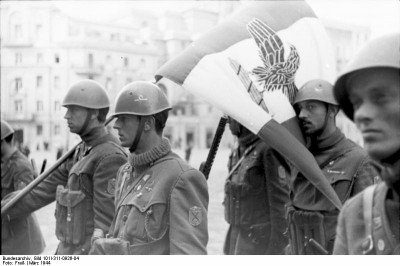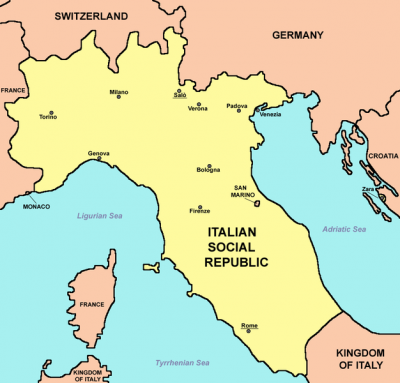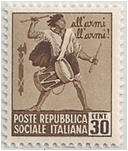ALBUM – view my Italian Social Republic album
TRANSITION CHART – Italy after unification
Region: Italy Area
Group: WW2 Occupations of Italy
Classification: Puppet State, Germany
Prior Regime: Fascist state of Italy / Kingdom of Italy
Key Dates:
1943, 24 Jul – Allied Forces land in Sicily
1943, Sept 12 – Mussolini rescued from prision by the Germansy
1943, Sept 23 – Mussolini established the Italian Social Republic
1945, Apr 25 – Italian Social Republic overthrown by partisian uprising and Allied offensive
Following Regime: AMG Occupation of Italy / Kingdom of Italy
Scott Catalogue: (Italy, Italian Socialist Republic) 1-34, E1-E3, EY1, J1-J13, Q1-Q12
Pick Catalogue: (Italy) 64-73
History

During World War 1, in a secret pact signed in Sept. of 1914 with Great Britain, France and Russia, the Kingdom of Italy agreed to join the “Triple Entente” and declare war on Austro-Hungary and Germany. In return, Italy would reap a share of agreed territorial gains after the war. This pact was nullified by the Treaty of Versailles, primarily because President Woodrow Wilson did not support the Italian claims in many of the territorial expansions, especially in Dalmatia. Instead, Italy was only awarded small tracts of Austrian territories and some future African lands. This disappointment caused great political upheavals in Italy, which resulted in the quick rise of the Fascist Party and Benito Mussolini.
In Oct, 1922, Benito Mussolini led the infamous March on Rome, which signaled the rise of power of the Fascists in Italy. King Victor Emmanuel III, fearing civil war, acquiesced to the demands. The King essentially became marginalized while Mussolini was appointed the youngest Prime Minister in Italian history. Within 5 years, using his feared secret police, Mussolini destroyed all political opposition and established a one-party, dictatorial fascist state.
As war again began looming on the horizon, Italy signed a treaty of friendship with Germany in 1936, and later signed an alliance called the “Pact of Steel” with Germany and Japan in 1939 formalizing the supply of military provisions. Ultimately this led to the 27 Sept, 1940 Tripartite Pact, which became known as the Axis alliance, and Italy joined World War 2. After a disastrous attempt to conquer Greece, Italy pleaded for help from Germany, and the combined forces were able to quickly overpower Greece in May of 1942. Most of the important cities of Greece were occupied by the Nazis while Italy controlled the majority of the Peloponnesian peninsula, including the Ionian Islands.
As the war continued, regrouped Allied forces began an attack on Italy, invading Sicily in June, 1943. Realizing the Italian Army would be unable to defeat repel an advancing army, the Grand Council of Fascism rejected Mussolini with a vote of no confidence and asked King Victor Emmanuel to resume his full “constitutional powers”. The King had Mussolini imprisoned, and privately began negotiating an armistice with the Allies. On 8 Sept, 1943, as the Allies were moving into Southern Italy, the King publicly announced an agreement with the Allies without prior notice to his armed forces. Confusion reigned, as troops were unsure of how to react. Germany, who had been expecting such a move, quickly disarmed and captured Italian forces, including much of Italy. Many of those troops did not surrender and fought the Germans, while others joined the Allied forces.
On 12 Sept, 1943, the Germans rescued Mussolini from imprisonment, and on 23 Sept, he established the Italian Social Republic, a fascist state in northern Italy. While never more than a German puppet, it was largely dependent on German troops to maintain order, and was only recognized by Germany and its occupations.

The Italian Social Republic declared Rome as its capital, but was essentially centered in the small town of Salò on Lake Garda in Northern Italy, where Mussolini and his government were located. While publicly proclaiming to be in full control, Mussolini had no real power as there was no constitution, organized economy, and depended entirely on funding from the Nazi regime.
Meanwhile, Allied forces, in a series of bloody battles, continued to advance north taking control of Rome in June, 1944. As the war went against the Germans, RSI territory shrank. In Jan/Feb, 1944, The situation became so desperate that Mussolini and his officials were secretly planning to flee to Germany while publicly declaring to “fight to the last Italian”.
The end of the RSI came on 25 April, 1945, after the Allies had liberated most of Italy, when a general uprising of partisans supporting the Allies rose up against the regime. Mussolini, his mistress, and other officials were captured by the partisans on 27 April 1945 attempting to flee, and on the next day most of the captives were shot. On 2 May, 1945, the rest of RSI ministers acquiesced, as German forces in Italy surrendered.
Stamps
 ALBUM
ALBUM
Stamps of the RSI can be roughly classified into three “periods”: 1) the military period, where Italian stamps were overprinted G.N.R, 2) the “fasces” period, and 3) the period where the RSI printed its own designs.
During the military period, the RSI overprinted stamps from the Italian “Imperial set” of 1929-42, with the letters “G.N.R.” (Republican National Guard). The stamps were overprinted in red or black, and were used from Dec, 1943- May of 1944. There were two printings of these issues.
On 21 Jan, 1944, the RSI again overprinted stamps from the Imperial set in Rome, Verona, Milan, Florence, Genoa and Turin with the “fasces” and/or including the words “Repubblica Sociale Italiana”. The Fascists adopted the image of the “fasces”, an ancient Roman symbol of power, which was a bundle of sticks holding an axe carried by Roman lictors indicating their power over life and death. The “fasces” overprints were also applied to Postage due, Authorized Delivery, Special Delivery and Parcel Post Stamps.
Beginning on 5 Jun, 1944, the RSI issued a set of 4 definitive stamps featuring various destroyed monuments as well as a drummer design. Additional designs were issued in August, 1944.
Additionally, in Dec, 1944, a set of 3 stamps were issued to commemorate the100th anniversary of the execution of the Bandiero brothers, who were executed at Cosenza on July 23, 1844 by Neapolitan authorities. Although some of the stamps continued in use after the fall of the regime, they were replaced by stamps of the Kingdom of Italy.
There are also many other unofficial overprints, which are valued by specialists.
Banknotes
After the fall of the fall of the Italian government, and the establishment of the RSI in the north, banknotes were issued in 1943 by the RSI in denominations of 50, 100, 500 and 1000 lira. These notes were issued under the Banca d’Italia and never used the Repubblica Sociale Italiana designation. In the south, as Allied troops took control, initially AMG (Allied Military Group) issued temporary currency until notes could be issued for the interim government in 1944 within the liberated areas.
Links
The Italian Social Republic from History in an Hour
Stamps of the Italian Social Republic by Giorgio Bifani
Stamps of Italy – Italian Social Republic
GNR overprint on Stamps





I’m sure you meant Jim. 😉
Italy is among my all time favorite trips and memories.
When we were 25, we spent a week in Rome and surroundings, and told each other we would come back every three years or so. But other priorities ensued, and we have not returned. Ah, the innocence of young adulthood before career demands and children. 😉
Jim
Sorry, of course I didn’t mean Joe (darn smartphones). 😳 I changed it so I don’t look too much the idiot. I understand completely how life gets in the way of the best of plans, although now that you are retired, who knows ….
We too love Italy, and travel in general is one of our passions. I am “redoing” our other site (farplaces.org) which covers some of the places and pictures we have visited.
Michael
Just beyond my time era coverage, so I don’t have to deal with it. 😉
Fantastic write-up- I learned a great deal.
Your “Italian” map is quite useful for the complicated WW II/ post WW II period.
Thanks Jim
for your usual nice words. I was just in Italy last week, and we visited Venice for the first time. One of my favorite cities (provided you get off of the crowded tourist trails). Italy has a long and winding history, even in the stamp issuing era (Italian states, occupations, kingdom, revolution, colonies, etc.) which I tried to unravel in the transition charts (Italy took two).
Michael